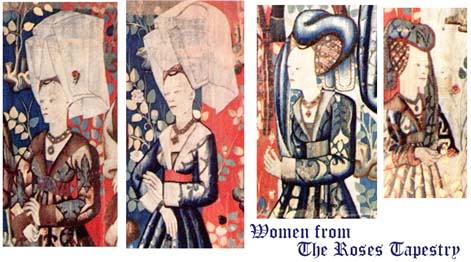 Summary
of possible means of constructing complex hats
Summary
of possible means of constructing complex hats Summary
of possible means of constructing complex hats
Summary
of possible means of constructing complex hatsMuch to the sorrow of folks who are interested in hats from the fifteenth century, not a single one survives, so all theories of construction must be based on various levels of conjecture. I've brought several examples that I have made myself, for folks to look at. Below is a table of "conjecturally period" methods that the medieval people might have used to make these fascinating hats.
These are listed roughly in order of complexity to make with crafter's
abilities today. Note that these methods are proposed for the functional
support or structure of the hats; they would then likely be covered by
fancy fabrics, jewels, netting, etc, per the contemporary pictures available.
| Method | Historical Support | Advantages | Disadvantages |
| Stuffed fabric (supporting classic stuffed roll; underpinning) | Women's "chaperon" type hats were said to be stuffed with hair. No extant items of this sort. | Easy to make; cheap, lightweight | The bonnet shape collapses under the weight of a stuffed roll, tall veils and wires, long pins, dags. |
| These hats were all their hair, braided up into shape | Women did grow their hair very long, and horsehair extensions were available. | Cheap, can be formed into many shapes | Very heavy for the volume attained; might not support large wires, veils. |
| Stiff woven fabrics, possibly stiffened with hide glues, wax, starch, etc. | They did have these materials available to them. | Relatively easy to make; cheap, lightweight. Making the rounded shapes might be difficult with a sheet of stiff stuff; could be molded to shape before glue sets, however. | Starched items would loose their stiffness after long use or exposure to water; this is probably not the best choice as they would have to be reblocked regularly. Tougher hide glues might well be a solution. |
| Basketry, traditional cane or wood strips | We know they had baskets.... | Sturdy. Can be made in many shapes. Cheap to make if you have the skills; cheap to buy if you want hats that follow commercial forms. | Heavy; may give you a headache after a few hours of wear. Inflexible; may cause blistering or rub off your hair on tight spots. |
| Basketry, straw or "bents" | Bents were used for corset stiffening a little later in time, per Arnold. Arnolfini Marriage - husband's hat is black straw. Van der Weyden's portrait of a lady? Contemporary drawing of balzo support made of reeds. | Flexible and lightweight for easy wearing. Easy to sew fabric to or through. Cheap. | Lightweight; flexible enough to sit on head well. Can support high wires & veils |
| Stiff felt | Some men's hats seem to be made of felted wool; later felt hats are extant. | Lightweight, easy to form into complex shapes if you have the right technology. Might be easy to crank out multiples. Can sew through. | Right shapes difficult to get these days; beyond average crafting ability to get very stiff felts. |
| Cardboard | V&A has supportasse (1600s) made of silk-covered cardboard. | Similar advantages to felt. | Depending on glues, should not get wet. Not that it's likely a noblewoman would be out in a downpour. |
| Leather, either regular or "cuir bolli" | They had lots of it available, in different weights. | Could be formed when wet and would stiffen as it dried. Similar advantages to felt. | Should not get wet. Might be heavy and inflexible if stiff enough to be self-supporting |
| Wire frames with padding | Thread-wrapped wire on circlet, also loop of thread-wrapped wire of undetermined use, from the Museum of London books. | No restriction on size & shape; relatively easy to fashion; flexible, can be sewn through. | Takes some time to make. |
| Woven or netted gold wire, suffiently strong to be self-supporting | At least one effigy looks very much like this option; other illustrations and effigies do not. How to explain jewels between the "wires?" | Would be very pretty; linings could be changed easily. Not too heavy. | Complex to make; would need a jeweler's skill and a lot of time. |